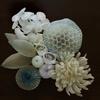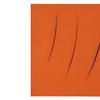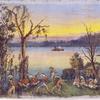Frank Stella Retrospective Hits the West Coast
- SAN FRANCISCO, California
- /
- November 09, 2016
The Fine Arts Museums of San Francisco now presents Frank Stella: A Retrospective, an expansive presentation surveying the career of this towering figure in post-WWII American art. Fifty works, including paintings, reliefs, sculptures and maquettes, are on display at the de Young, representing Frank Stella’s prolific output from the late 1950s to the present day. This is the first comprehensive U.S. presentation devoted to the artist since 1970.
“Frank Stella’s impact on abstract art is unmatched,” says Max Hollein, Director of the Fine Arts Museums of San Francisco. “This retrospective is timely and important for San Francisco audiences. To see the development of an artist who created ‘masterpieces’ just one year out of college, who is still working as a major force today—it is impressive to see an extraordinary body of work that spans six decades.”
Stella first burst into the New York art world in 1959, at the age of twenty-three, when four of his Black Series (1958-1960) paintings were included in the group exhibition, Sixteen Americans, at the Museum of Modern Art. In the following six decades he has remained one of the most important and influential figures in the evolution of modern art. Stella anticipated and pioneered many of the explosive changes in the art world, and remains an enduring figure of both critical and popular attention, as well as controversy.
“Frank Stella’s works span the spectrum of art from Minimalist to Maximalist,” notes Timothy Anglin Burgard, Curator-in-Charge of American Art at the Fine Arts Museums of San Francisco. “In both ambition and achievement, his work appears to be the output of a dozen different artists. By combining intellectual rigor with aesthetic audacity these works have transformed the history of art.”
As part of the exhibition, Das Erdbeben in Chili [N#3] (The Earthquake in Chile) (1999) – one of Stella’s largest works, measuring 12 x 40.5 ft. – will be installed in Wilsey Court. Das Erdbeden in Chili will transform the space beginning October 24, 2016.
Frank Stella: A Retrospective comes to the de Young after a premiere at the Whitney Museum in New York and a showing at the Modern Art Museum of Fort Worth, Texas. It will be on view in San Francisco from November 5, 2016 through February 26, 2017. The curator for the de Young’s presentation is Timothy Anglin Burgard
The exhibition opens with paintings that Stella created as he forged his identity as an artist, including East Broadway and Great Jones Street (both 1958). Both works emulate and critique Abstract Expressionism, the dominant art movement of the time, but also reveal Stella’s early interest in the manipulation of space.
The artist’s subsequent work, the legendary series of Black paintings (1958–1960) which includes Die Fahne hoch! (1959) are formed exclusively of parallel bands of black paint separated by thin strips of unpainted canvas. Simple in form but far-reaching in their implications, these paintings inspired both painters and sculptors associated with the emerging Minimalist art movement.
The following Aluminum (1960) and Copper (1961) series employ shaped canvases, a radical innovation that rejected the traditional conception of a painting as a pictorial “window” into another space or realm. Works such as Creede II (1961) blur the boundaries between the art and its environment.
Turning from the monochromatic palettes of his previous works, Stella reintroduced vivid colors in the Benjamin Moore (1961) series, created with commercial house paints. Jasper’s Dilemma (1962) from the Mitred Maze (1962–1963) series, confront both the artist and the viewer with a choice between the seductive pleasures of color and the intellectual possibilities of monochrome.
While non-rectangular formats have been used throughout painting’s history, few artists have explored the potential of these forms with comparable rigor and insight as Stella. The Irregular Polygons (1966–1967) series, including Conway I (1966) and Chocorua IV (1966), marked a pivotal movement that bridged Stella’s emphasis on two dimensions in his early striped paintings and the potential for working in three dimensions in his later relief works.
Stella’s monumental works from the Protractor (1967–1971) series, such as Damascus Gate Stretch Variation III (1970), challenged the art world idea that modern art should not be beautiful, let alone popular. The artist believed that abstract painting had reached a crucial stage—embraced by critics, collectors, and curators, but lagging behind new developments in contemporary art.
Seeking to make abstract painting relevant again, Stella subverted the traditional boundaries of the medium with the Polish Village (1970–1974) series, projecting his works into the viewer’s space. Subsequent works such as Eskimo Curlew (1976), from the Exotic Bird (1976–1980) series and Talladega (1980), from the Circuit (1980–1984) series, incorporate an increasingly sculptural vocabulary of solids and voids.
Stella developed his own expanded conception of space in the Cones and Pillars (1984–1987) series, which included works such as Gobba, Zoppa e Collotorto (1985). Monumental reliefs from the Moby-Dick (1986–1997) series such as The Whiteness of the Whale (USB-1, 2X) (1987) expand space further with forms that suggest perpetual energy and motion.
The exhibition concludes with recent works, including those that Stella has created using advanced technologies such as computer-aided design software and three-dimensional printing. In works including K.144 (2013), which evokes the experience of listening to music in space and time, Stella has de-emphasized the sculptural properties of mass and weight, in favor of gravity-defying forms that convey the ways in which sounds can fill—and seemingly shape—space.
About the Artist
Born in Malden, Massachusetts, in 1936, Frank Stella attended Phillips Academy, in nearby Andover, and Princeton University, where he studied art history and painting. After graduation, he established permanent residence in New York City and achieved near-immediate fame with his Black Paintings (1958–1960). Throughout his career, Stella has continued to challenge and expand the boundaries of painting and sculpture. Though his early work influenced and allied him with the emerging Minimalist movement, Stella did not regard himself as an adherent of Minimalism, and his art has become visually more complex and dynamic over the years. Evolving away from a restrained aesthetic, Stella’s compositions became increasingly ambitious and exuberant in form, color, and scale.
In conjunction with Frank Stella: A Retrospective, the de Young will also present Frank Stella’s Prints, a focused exhibition highlighting the artist’s experimental printmaking over 25 years. Starting in 1967, about 40 examples will be drawn from the Museum’s Anderson Collection of Graphic Arts showing Stella’s dexterity with medium. Though he came to printmaking somewhat reluctantly, he eventually discovered its potential and continued with the form, beginning with lithography, moving to screen printing, and eventually combining multiple printmaking processes. Many pieces in the exhibition mirror those paintings in the retrospective including Jill (1967) from the Black Series II, Squid (1989) from The Waves series and The Cabin. Ahab and Starbuck (Dome) (1992) from the series, Moby Dick Domes.
















